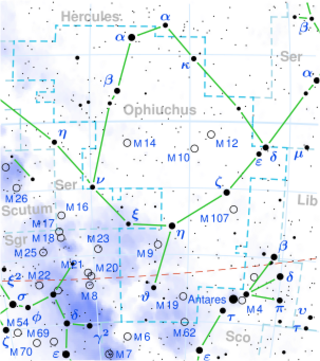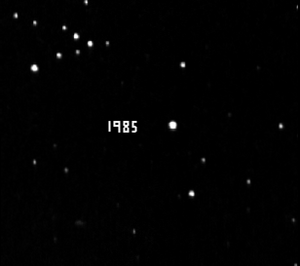Barnard's Star facts for kids
Barnard's Star is a small, cool star called a red dwarf. It's found in the constellation of Ophiuchus. This star is about 5.96 light-years away from Earth. That makes it the fourth closest star to our Sun. Only the three stars in the Alpha Centauri system are closer. Barnard's Star is the closest star you can see in the northern part of the sky.
This star is much smaller than our Sun. It has about 16% of the Sun's mass and 19% of its size. Even though it's quite close, Barnard's Star is too dim to see without a telescope. It looks much brighter when viewed with infrared light than with regular light.
The star is named after E. E. Barnard. He was an American astronomer. In 1916, he found that Barnard's Star moves faster across the sky than any other known star. This movement is called its proper motion. The star had been seen before on photographic plates in 1888 and 1890.
Scientists study Barnard's Star a lot. This is because it's close and easy to watch. They measure its features and how it moves. They also look for any extrasolar planets around it. Barnard's Star is very old, but it still has sudden bursts of energy called stellar flares. One was seen in 1998.
People have claimed to find planets around Barnard's Star many times. But these claims were later proven wrong. From the 1960s to the 1970s, an astronomer named Peter van de Kamp said he found large planets. But other scientists showed he was mistaken. In 2018, a new planet candidate was announced. It was called Barnard's Star b. But in 2021, scientists found that this signal was actually from the star itself, not a planet.
| Observation data Epoch J2000.0 Equinox J2000.0 |
|
|---|---|
| Constellation | Ophiuchus |
| Right ascension | 17h 57m 48.49847s |
| Declination | +04° 41′ 36.1139″ |
| Apparent magnitude (V) | 9.511 |
| Characteristics | |
| Spectral type | M4.0V |
| Apparent magnitude (U) | 12.497 |
| Apparent magnitude (B) | 11.240 |
| Apparent magnitude (R) | 8.298 |
| Apparent magnitude (I) | 6.741 |
| Apparent magnitude (J) | 5.24 |
| Apparent magnitude (H) | 4.83 |
| Apparent magnitude (K) | 4.524 |
| U−B color index | 1.257 |
| B−V color index | 1.713 |
| V−R color index | 1.213 |
| R−I color index | 1.557 |
| Variable type | BY Draconis |
| Astrometry | |
| Radial velocity (Rv) | −110.47±0.13 km/s |
| Proper motion (μ) | RA: −801.551 mas/yr Dec.: 10362.394 mas/yr |
| Parallax (π) | 546.9759 ± 0.0401 mas |
| Distance | 5.9629 ± 0.0004 ly (1.8282 ± 0.0001 pc) |
| Absolute magnitude (MV) | 13.21 |
| Details | |
| Mass | 0.1610+0.0036 −0.0035 M☉ |
| Radius | 0.187±0.001 R☉ |
| Luminosity (bolometric) | 0.00340+0.00006−{{{2}}} L☉ |
| Luminosity (visual, LV) | 0.0004 L☉ |
| Temperature | 3,223±17 K |
| Rotation | 145±15 d |
| Age | ≈ 10 Gyr |
| Other designations | |
|
Proxima Ophiuchi, "Barnard's Runaway Star", "Greyhound of the Skies", V2500 Ophiuchi, BD+04°3561a, GJ 699, HIP 87937, LFT 1385, LHS 57, LTT 15309, 2MASS J17574849+0441405, GCTP 4098.00, Gl 140-024, Karmn J17578+046, Munich 15040, Vyssotsky 799, Latin: Velox Barnardi
|
|
| Database references | |
| SIMBAD | data |
| ARICNS | data |
Contents
What is Barnard's Star?
Barnard's Star is a type of star called a red dwarf. It has a dim spectral type of M4. This means it's very cool and red. You need a telescope to see it because it's so faint. Its apparent magnitude is 9.5.
How Old is Barnard's Star?
Barnard's Star is very old. It's thought to be between 7 and 12 billion years old. Our Sun is only 4.5 billion years old. So, Barnard's Star might be one of the oldest stars in the Milky Way galaxy.
How Does it Rotate?
This star has slowed down a lot over time. It spins very slowly. Small changes in its brightness show that it takes about 130 days to spin around once. Our Sun spins much faster, taking about 25 days.
Does it Flare?
Because it's so old, scientists thought Barnard's Star would be quiet. But in 1998, astronomers saw a very strong stellar flare. This showed that Barnard's Star is a flare star. A flare is a sudden burst of energy. Barnard's Star is also known as V2500 Ophiuchi, which is its variable star designation. In 2003, scientists also saw changes in its radial velocity. This was caused by the star's movement.
How Barnard's Star Moves
Barnard's Star moves very fast across the sky. Its proper motion means it travels at 90 kilometers per second (about 56 miles per second). In one year, it moves 10.3 arcseconds. That's about a quarter of a degree in a human lifetime. This is roughly half the size of the full Moon in the sky!
Its Speed and Future Path
The star is also moving towards our Sun. Its radial velocity is about 110 kilometers per second (68 miles per second). This is measured by a blueshift in its light. When we combine its speed across the sky and its speed towards us, we get its true speed. This "space velocity" is about 142.6 kilometers per second (88.6 miles per second) relative to the Sun.
Barnard's Star will come closest to the Sun around the year 11,800 CE. It will be about 3.75 light-years away then. Even at its closest, it won't be the nearest star. Proxima Centauri will still be closer. Also, Barnard's Star will still be too dim to see without a telescope. It will only be a little brighter than it is now.
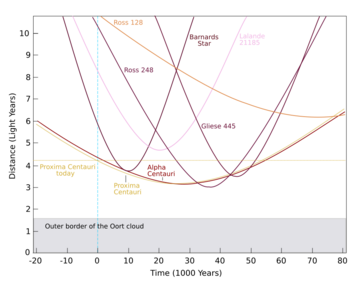
Size and Brightness
Barnard's Star has about 0.16 times the mass of our Sun. Its radius is about 0.2 times the Sun's radius. So, it's about 150 times heavier than Jupiter. But it's only about 2 times bigger than Jupiter. This is because it's much denser.
Its temperature is about 3,220 kelvin. It gives off very little light, only 0.0034 times the Sun's brightness. If Barnard's Star were as close as our Sun, it would only be about 100 times brighter than a full moon. That's like how bright the Sun looks from 80 astronomical units away.
What it's Made Of
Barnard's Star has less "metal" than the Sun. In space, "metal" means any element heavier than helium. Its metal content is between 10% and 32% of the Sun's. This suggests it's an old star. Some recent studies suggest it might have more metal, closer to the Sun's level.
Looking for Planets Around Barnard's Star
Old Planet Claims
For about ten years, from 1963 to 1973, many astronomers believed that Barnard's Star had planets. Peter van de Kamp said he found them using a method called astrometry. This method looks for tiny wobbles in a star's movement. He thought these wobbles were caused by planets pulling on the star. Van de Kamp first suggested a planet about 1.6 times the mass of Jupiter. Later, he thought there were two planets.
But other astronomers tried to find these planets and couldn't. In 1973, two studies showed that Van de Kamp's findings were wrong. It turned out that the wobbles he saw were caused by changes to his telescope, not by planets. Van de Kamp never agreed he was wrong. He kept saying there were planets until he died in 1995.
The Search for Barnard's Star b
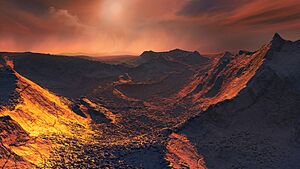
In November 2018, a group of astronomers announced they might have found a new planet. They used a method called radial velocity. This method looks for tiny shifts in a star's light caused by a planet's gravity. They called this possible planet Barnard's Star b.
It was thought to be a super-Earth. This means it's bigger than Earth but smaller than Neptune. Scientists thought it had at least 3.2 times the mass of Earth. It was believed to orbit Barnard's Star every 233 days. It would have been very cold, with a surface temperature of about -170 degrees Celsius (-274 degrees Fahrenheit). This would put it outside the star's habitable zone. The habitable zone is where temperatures might be right for liquid water.
However, in 2021, new research showed that the signal for Barnard's Star b was likely caused by the star's own activity, like flares, and not a planet. A study in 2022 confirmed this. So, for now, Barnard's Star b is not considered a confirmed planet.
Setting Limits for Planets
Even though no planets have been confirmed, scientists keep studying Barnard's Star. They use different methods to figure out what kind of planets *could* exist there. Because red dwarfs are smaller, it's easier to see if a planet is pulling on them.
Scientists have been able to rule out many types of planets. For example, in 1995, it was shown that planets as big as 10 times the mass of Jupiter couldn't be orbiting Barnard's Star. Later, in 1999, the Hubble Space Telescope helped rule out planets 0.8 times the mass of Jupiter with orbits shorter than 1,000 days.
In 2013, more detailed studies were done. They showed that planets larger than two Earth masses in very close orbits (less than 10 days) are unlikely. Also, planets more than ten Earth masses in orbits up to two years were ruled out. It seems that the habitable zone around Barnard's Star probably doesn't have Earth-sized planets or larger.
Stellar Flares
The 1998 Flare
In 1998, astronomers saw a stellar flare on Barnard's Star. This happened on July 17. It was found by accident while looking for other changes. It took four years to fully study the flare. Scientists found that the flare's temperature was about 8,000 kelvin. This is more than twice the star's normal temperature!
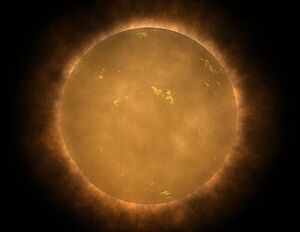
This flare was surprising because old stars like Barnard's Star are not expected to have such strong activity. Flares are thought to be caused by strong magnetic fields. These fields can cause sudden bursts of energy. Strong magnetic fields usually happen in stars that spin fast. But old stars tend to spin slowly. So, a big flare on Barnard's Star is probably rare.
Studying flares on Barnard's Star helps us understand other old red dwarf stars. It helps scientists learn how flares might affect planets that are close to these stars. This is important for understanding if life could exist on such planets.
Flares in 2019
In 2019, two more flares were seen in ultraviolet light. Each had a lot of energy. One X-ray flare was also detected. Scientists calculated that these flares could cause a planet like Barnard's Star b to lose its atmosphere over billions of years.
Barnard's Star's Neighborhood
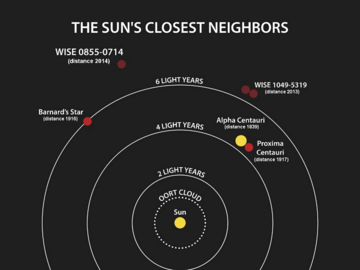
Barnard's Star is in a similar part of space as our Sun. Most of its neighbors are also small red dwarf stars. These are the most common type of star. Its closest neighbor is currently the red dwarf Ross 154. It's about 5.41 light-years away. Our Sun and Alpha Centauri are the next closest star systems.
If you were on a planet around Barnard's Star, our Sun would look like a bright star in the constellation Monoceros. It would be as bright as the star Pollux looks from Earth.
Ideas for Visiting Barnard's Star
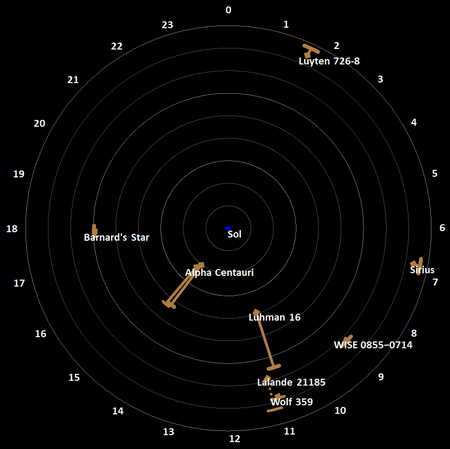
Project Daedalus
Barnard's Star was a target for a study called Project Daedalus. This project, from 1973 to 1978, looked at whether we could send uncrewed spacecraft to another star. Barnard's Star was chosen partly because people thought it had planets.
The idea was to build a rocket powered by nuclear fusion. This rocket could go as fast as 12% of the speed of light. At that speed, it could reach Barnard's Star in 50 years. That's within a human lifetime! The mission would study the star and any planets around it.
This project led to more ideas. In 1980, Robert Freitas suggested an even bigger plan. He thought about a self-replicating spacecraft. This spacecraft would be built near Jupiter. It would reach Barnard's Star in 47 years. Once there, it would build a factory to make copies of itself and new probes.
See also
 In Spanish: Estrella de Barnard para niños
In Spanish: Estrella de Barnard para niños
- Kepler-42 – A star similar to Barnard's Star, with three small planets.
- List of nearest stars and brown dwarfs
- Teegarden's Star



